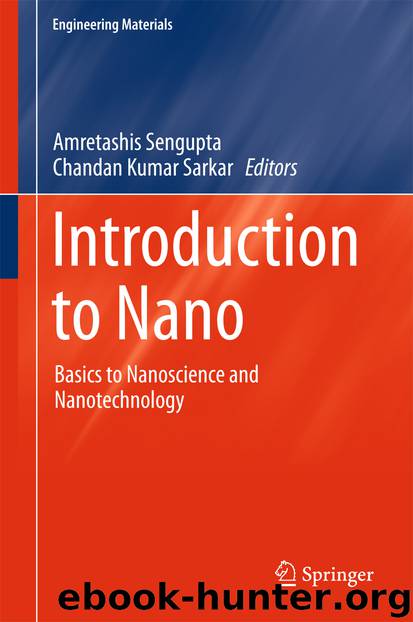Introduction to Nano by Amretashis Sengupta & Chandan Kumar Sarkar

Author:Amretashis Sengupta & Chandan Kumar Sarkar
Language: eng
Format: epub
Publisher: Springer Berlin Heidelberg, Berlin, Heidelberg
1.3.1 X-ray Lithography
X-ray lithography is one of the modern lithographic techniques that is being widely used in recent time to transfers the geometric patterns from a mask to the surface of the wafer (mainly Si). International Business Machines (IBM) first developed X-ray lithographic technique in the year 1969 and generated metal structure ~20 μm. In this lithographic technique, X-ray from synchrotron radiation is used to generate the pattern [17]. Similar to photolithography, the first step, involved in this lithographic technique, is the exposure of thick layer of resist via patterned mask to highly intensed X-ray beam. The pattern is then exposed to X-ray such that it gets etching into the resist substrate that results negative replica of the mask pattern. In order to remove unwanted material and resist materials (in case of free standing material), chemical treatment is carried out. The mask materials, generally used in X-ray lithography, are made of materials with low atomic mass (polymethyl methacrylate (PMMA) is used as resist material). In this context, it has to be mentioned that the mask materials with high atomic number can’t be used due to attenuation of X-ray. Primarily the requirement of choosing substrate is that it should be conducting in nature. Resolution of X-ray lithography is increased by decreasing wavelength of the X-ray. But the major problem that is inherent in this lithographic technique is the proper alignment of the mask with resist, since no visible light can penetrate through X-ray membrane.
Download
This site does not store any files on its server. We only index and link to content provided by other sites. Please contact the content providers to delete copyright contents if any and email us, we'll remove relevant links or contents immediately.
| Automotive | Engineering |
| Transportation |
Whiskies Galore by Ian Buxton(41712)
Introduction to Aircraft Design (Cambridge Aerospace Series) by John P. Fielding(33011)
Small Unmanned Fixed-wing Aircraft Design by Andrew J. Keane Andras Sobester James P. Scanlan & András Sóbester & James P. Scanlan(32678)
Craft Beer for the Homebrewer by Michael Agnew(18075)
Turbulence by E. J. Noyes(7888)
The Complete Stick Figure Physics Tutorials by Allen Sarah(7258)
Kaplan MCAT General Chemistry Review by Kaplan(6812)
The Thirst by Nesbo Jo(6748)
Bad Blood by John Carreyrou(6468)
Modelling of Convective Heat and Mass Transfer in Rotating Flows by Igor V. Shevchuk(6349)
Learning SQL by Alan Beaulieu(6152)
Weapons of Math Destruction by Cathy O'Neil(6076)
Man-made Catastrophes and Risk Information Concealment by Dmitry Chernov & Didier Sornette(5870)
Digital Minimalism by Cal Newport;(5576)
Life 3.0: Being Human in the Age of Artificial Intelligence by Tegmark Max(5396)
iGen by Jean M. Twenge(5294)
Secrets of Antigravity Propulsion: Tesla, UFOs, and Classified Aerospace Technology by Ph.D. Paul A. Laviolette(5232)
Design of Trajectory Optimization Approach for Space Maneuver Vehicle Skip Entry Problems by Runqi Chai & Al Savvaris & Antonios Tsourdos & Senchun Chai(4949)
Electronic Devices & Circuits by Jacob Millman & Christos C. Halkias(4859)
